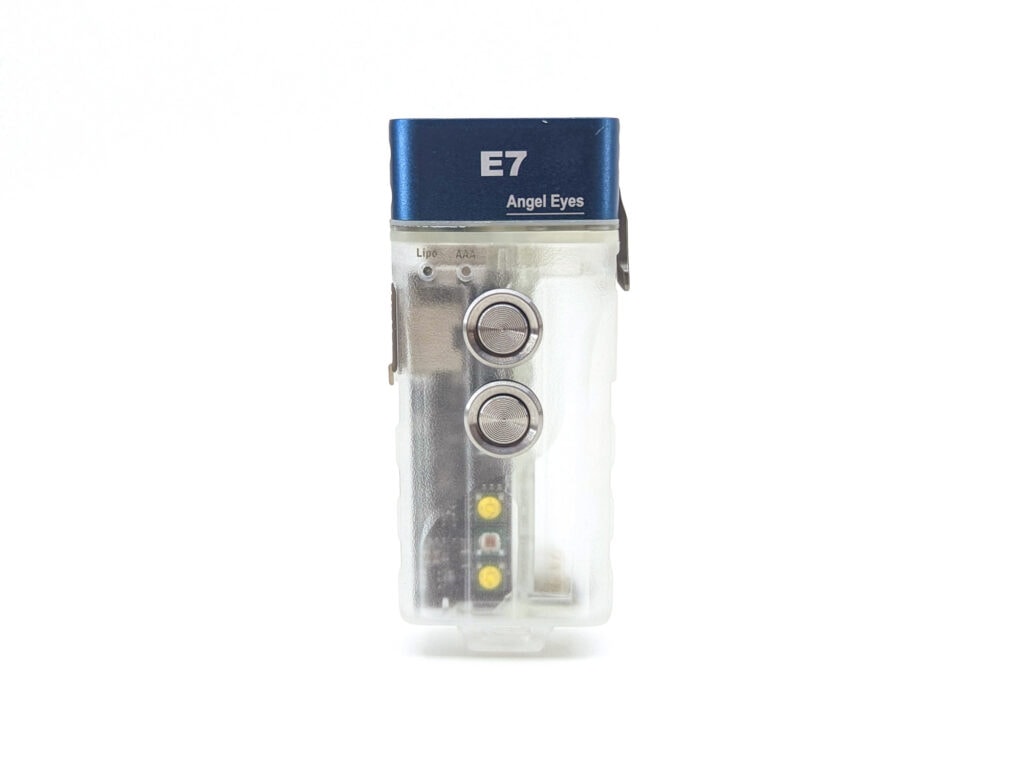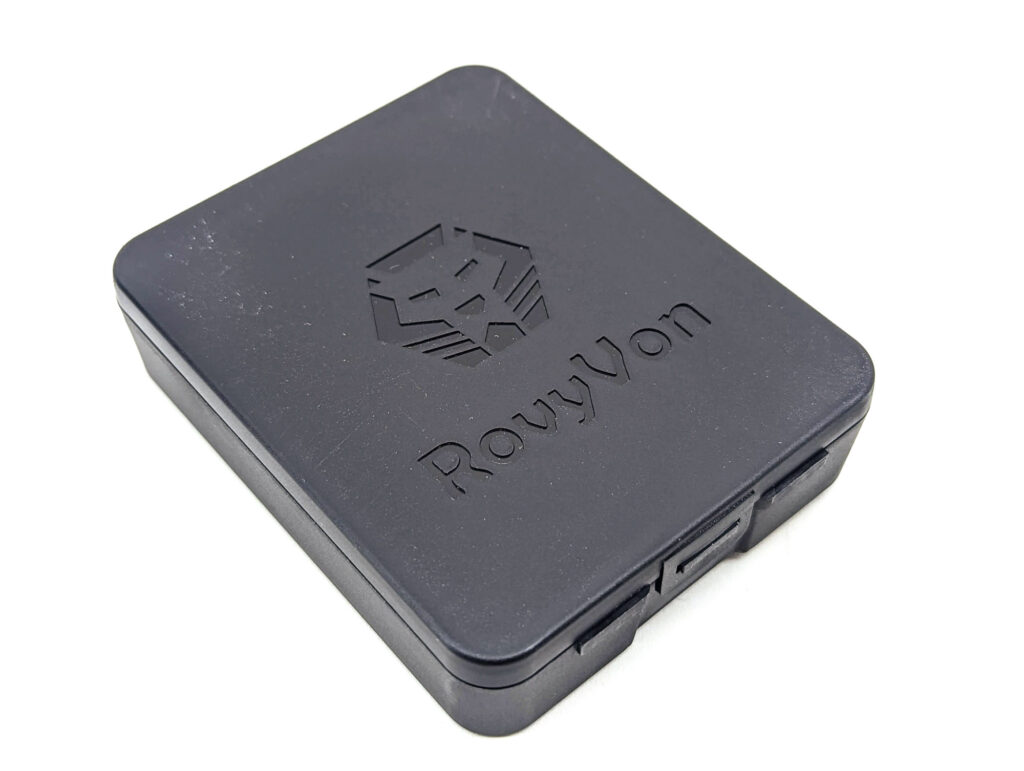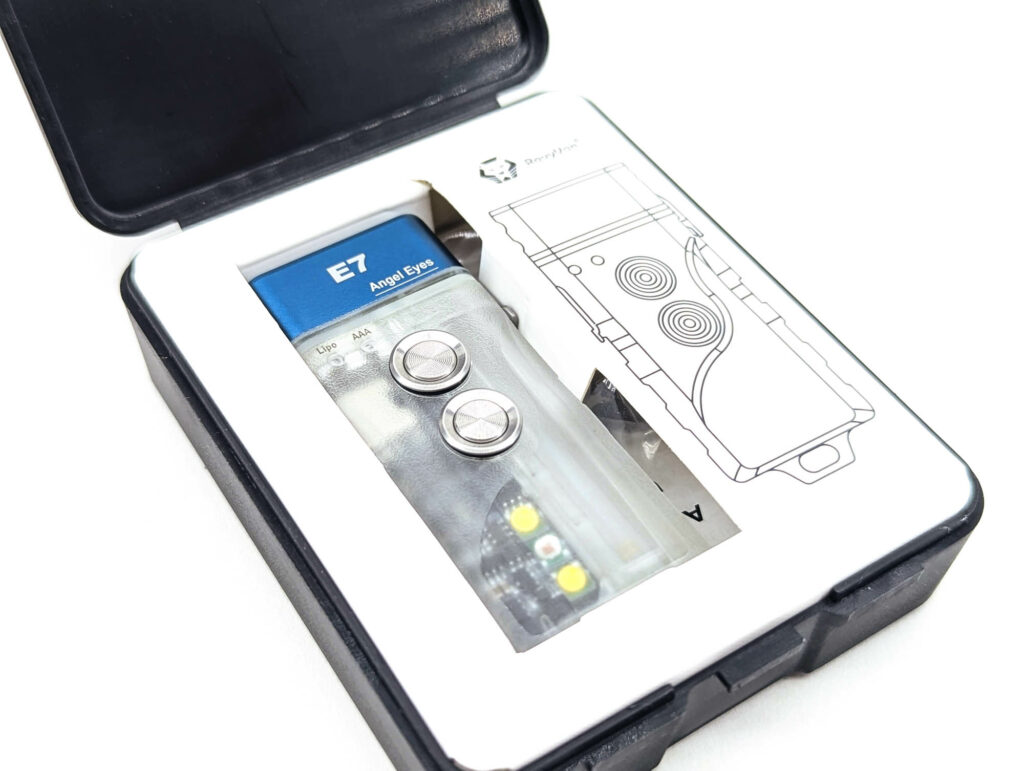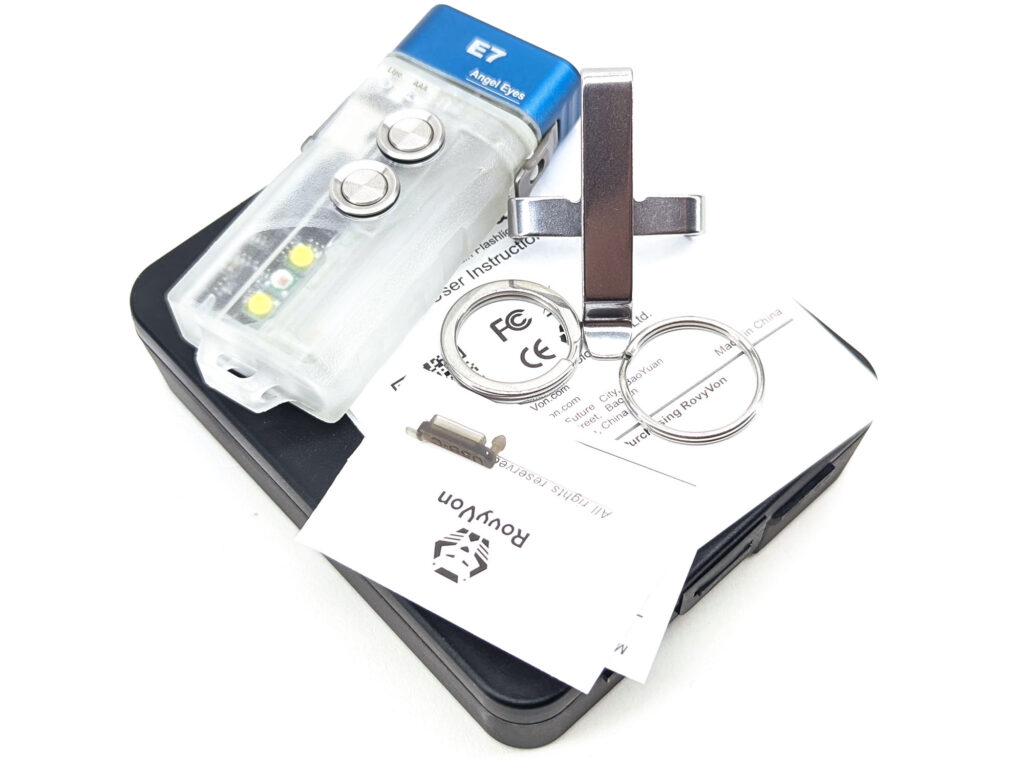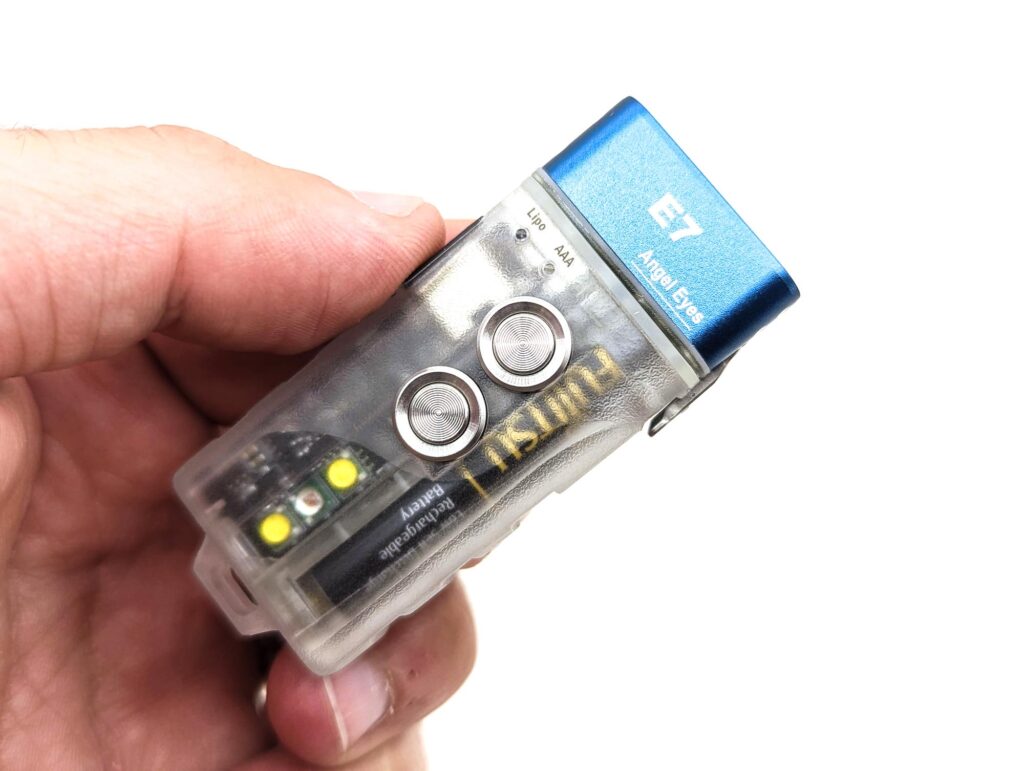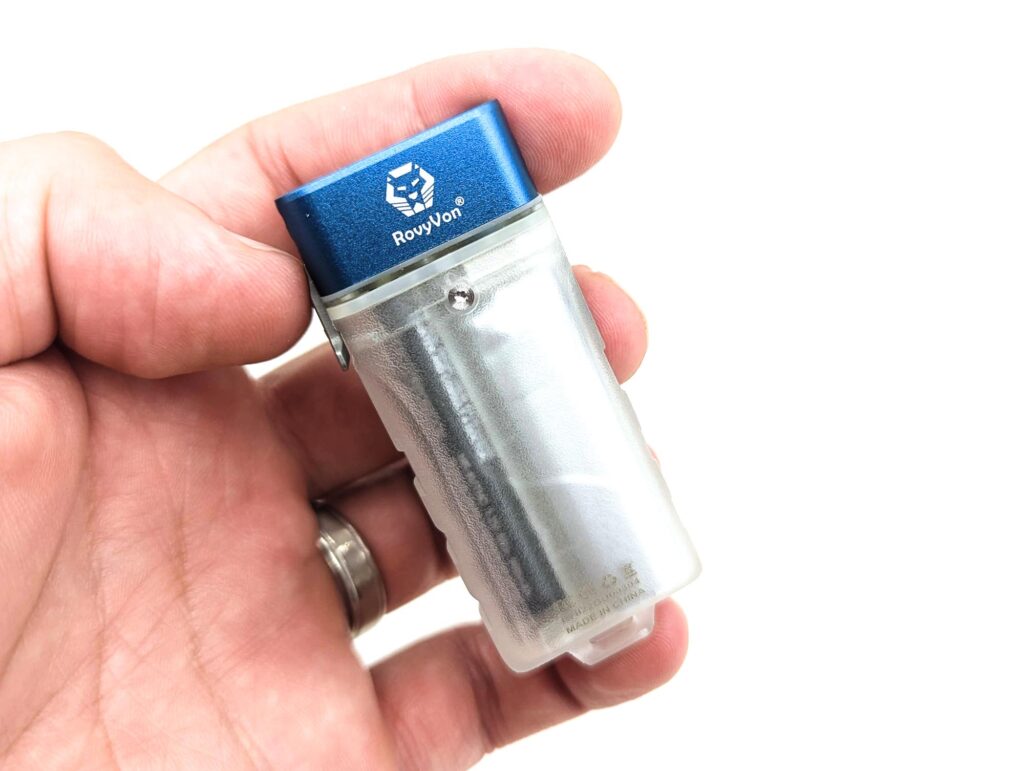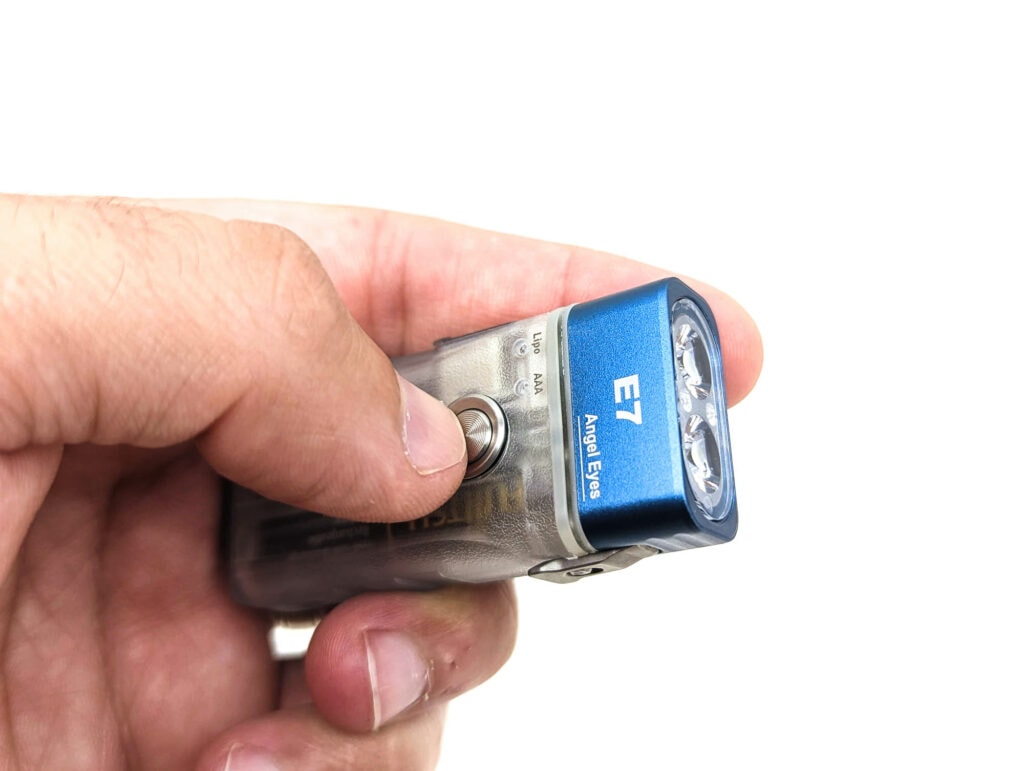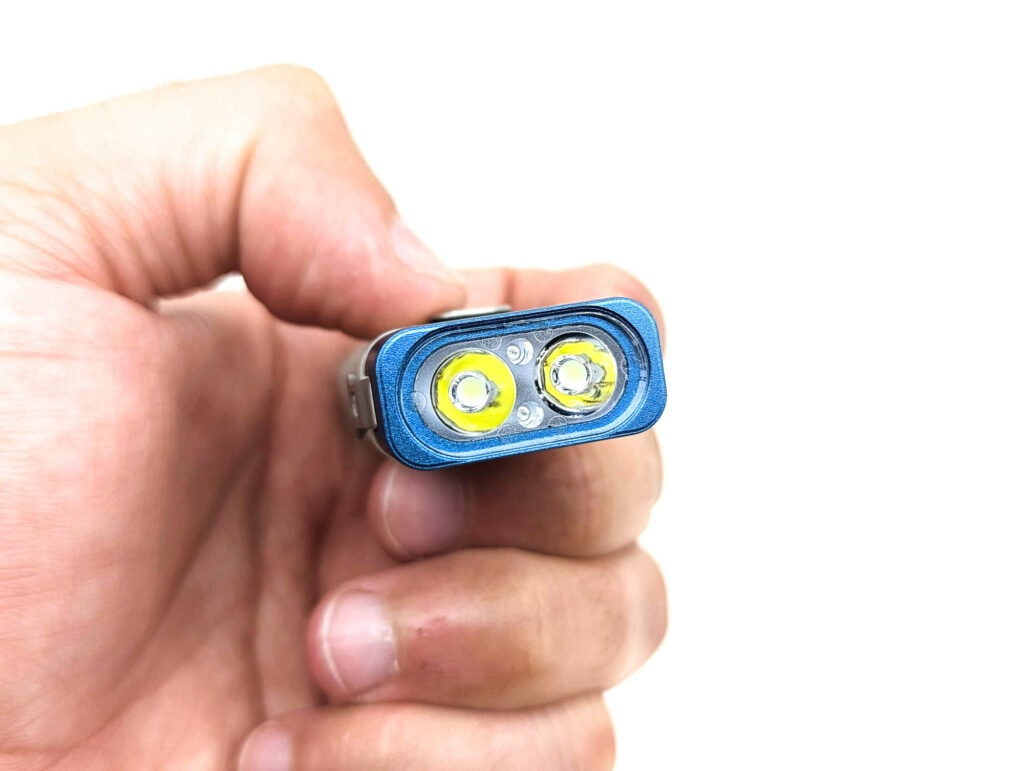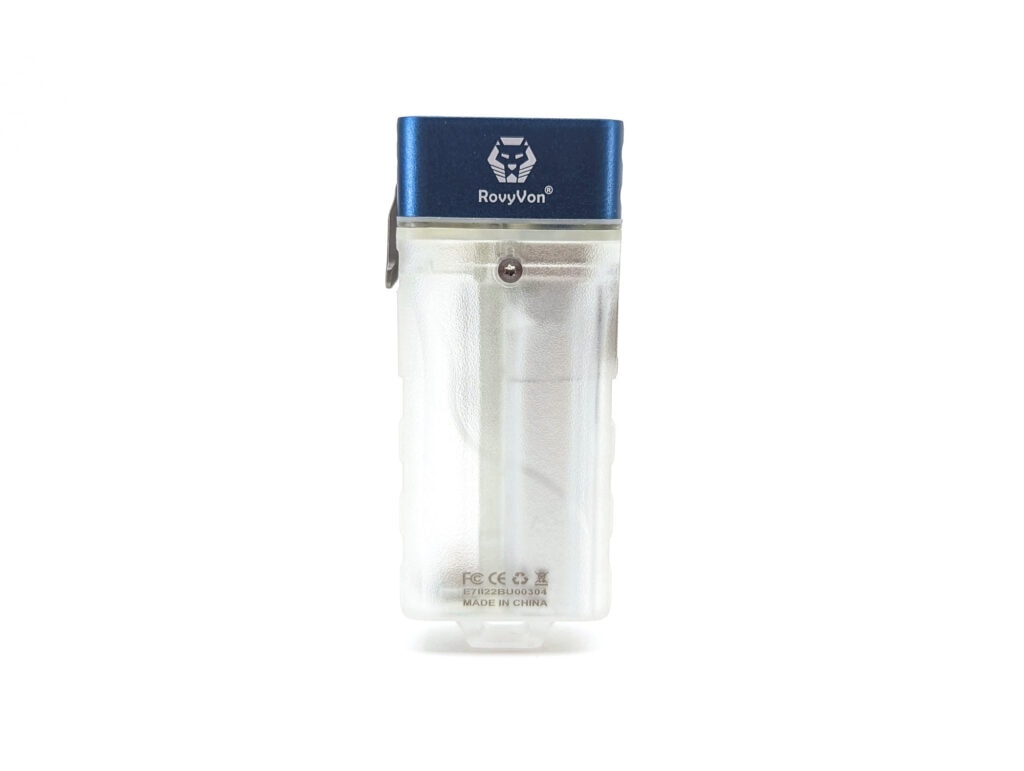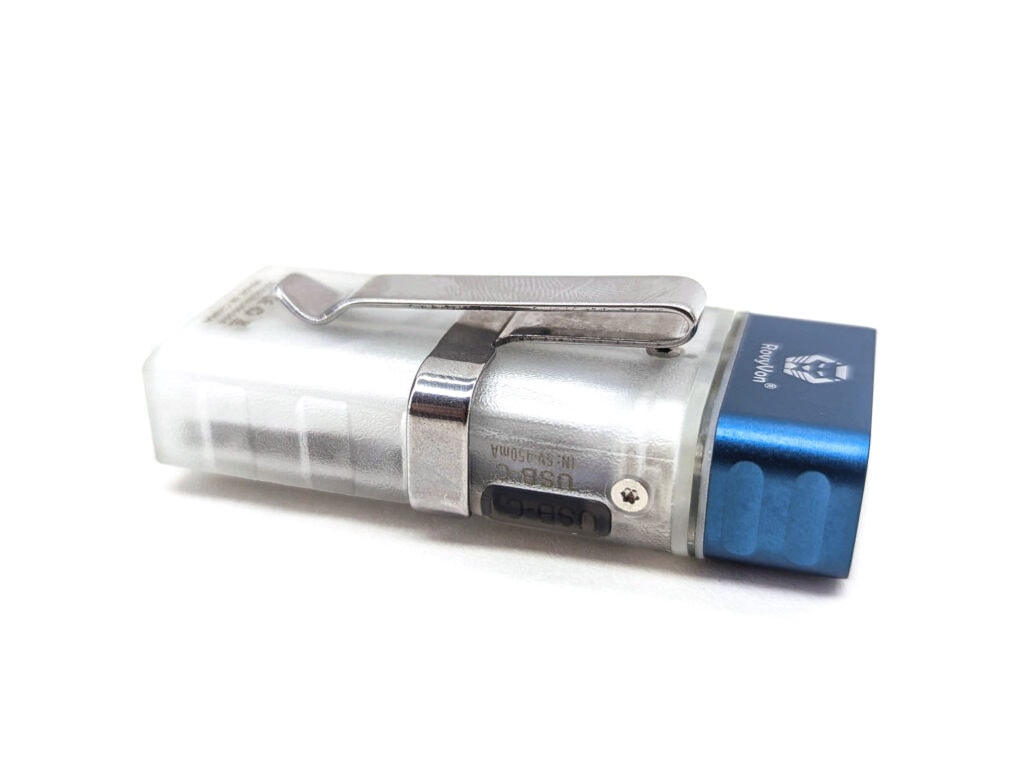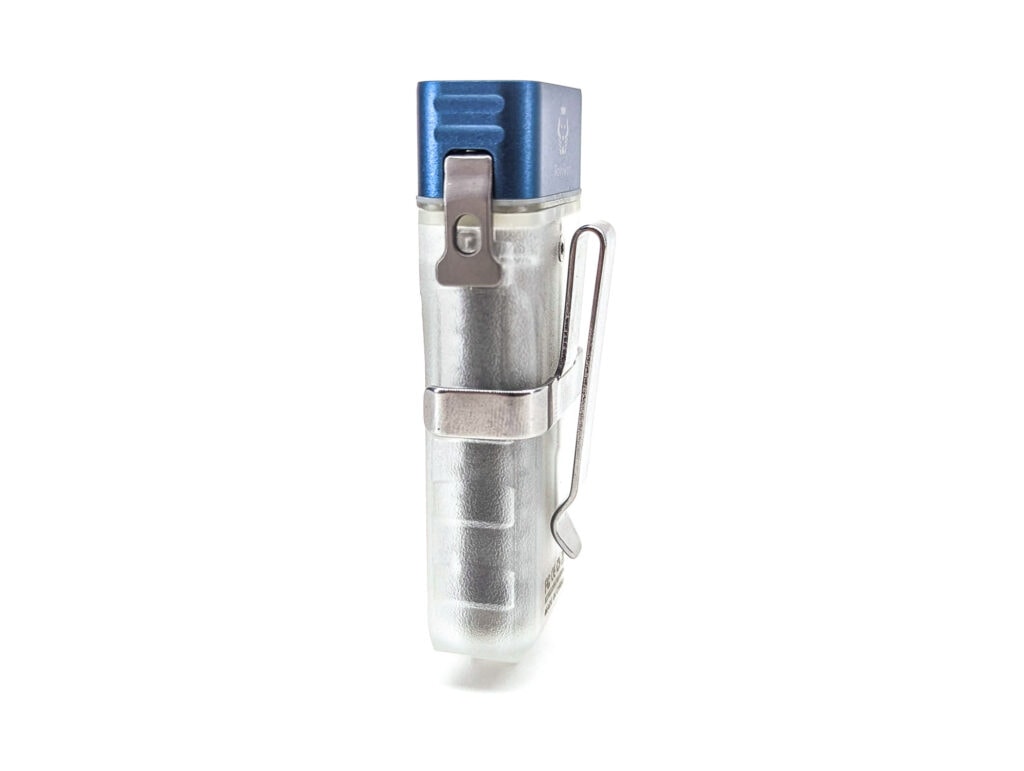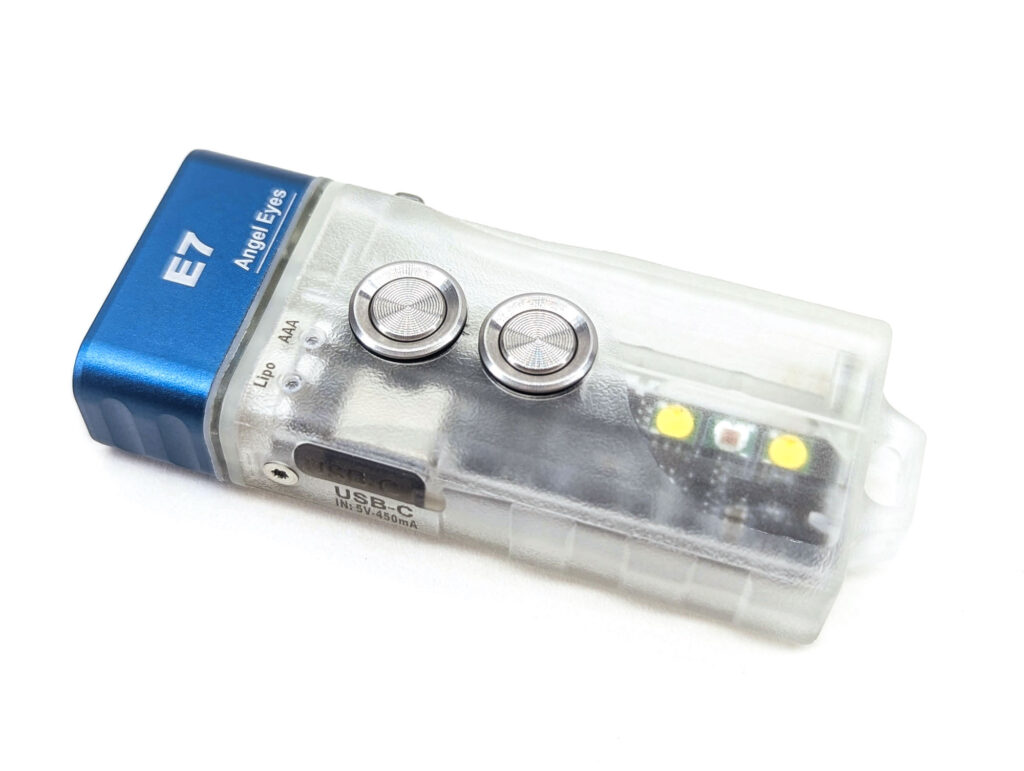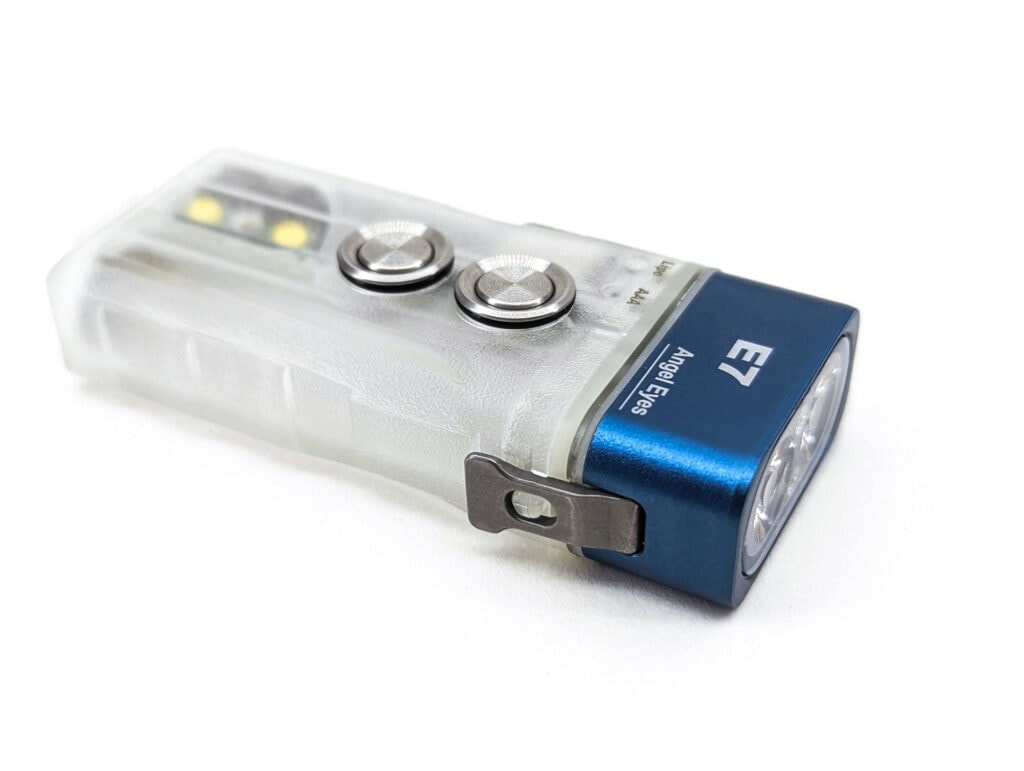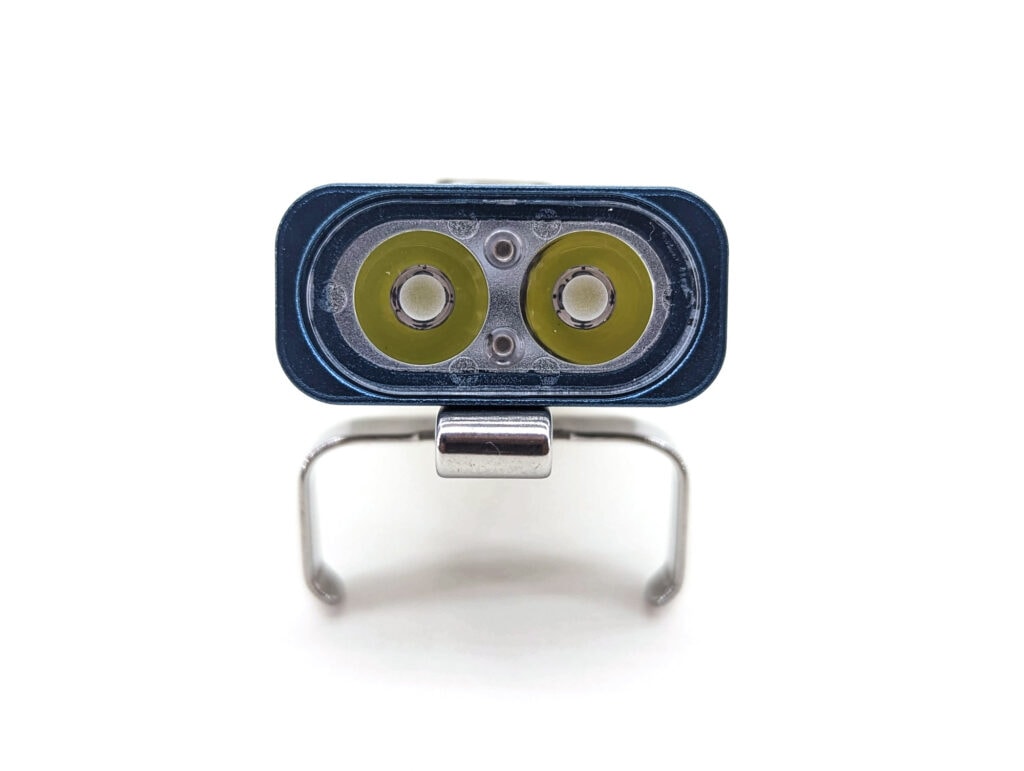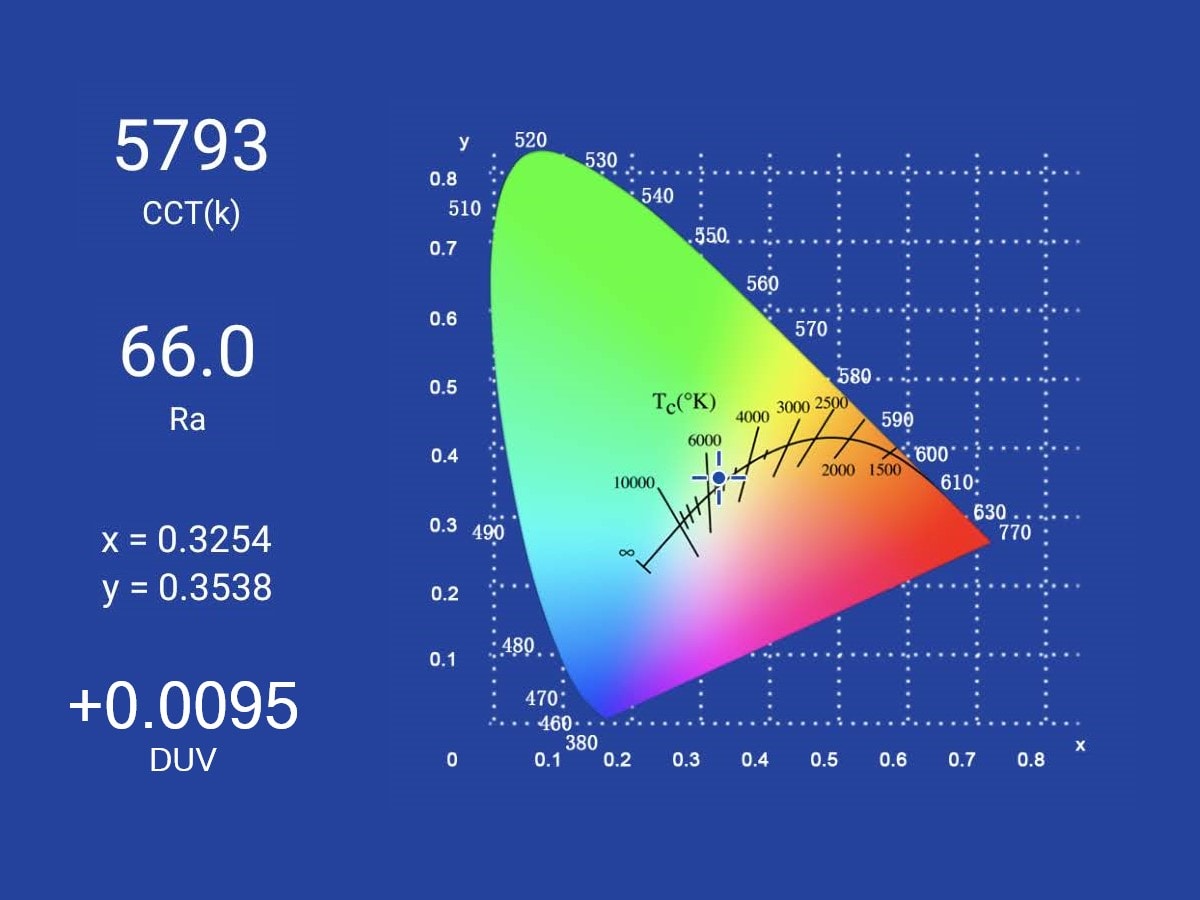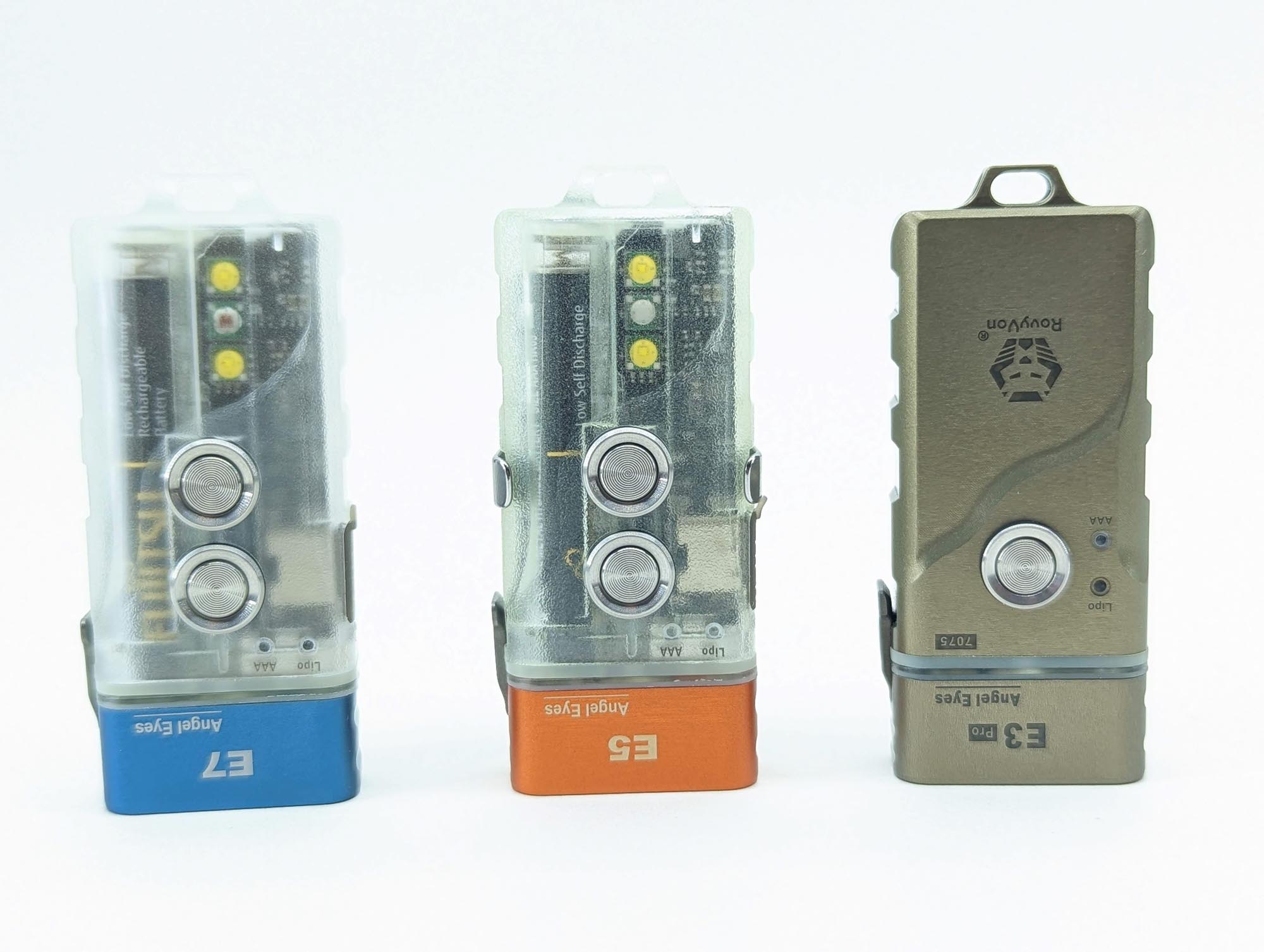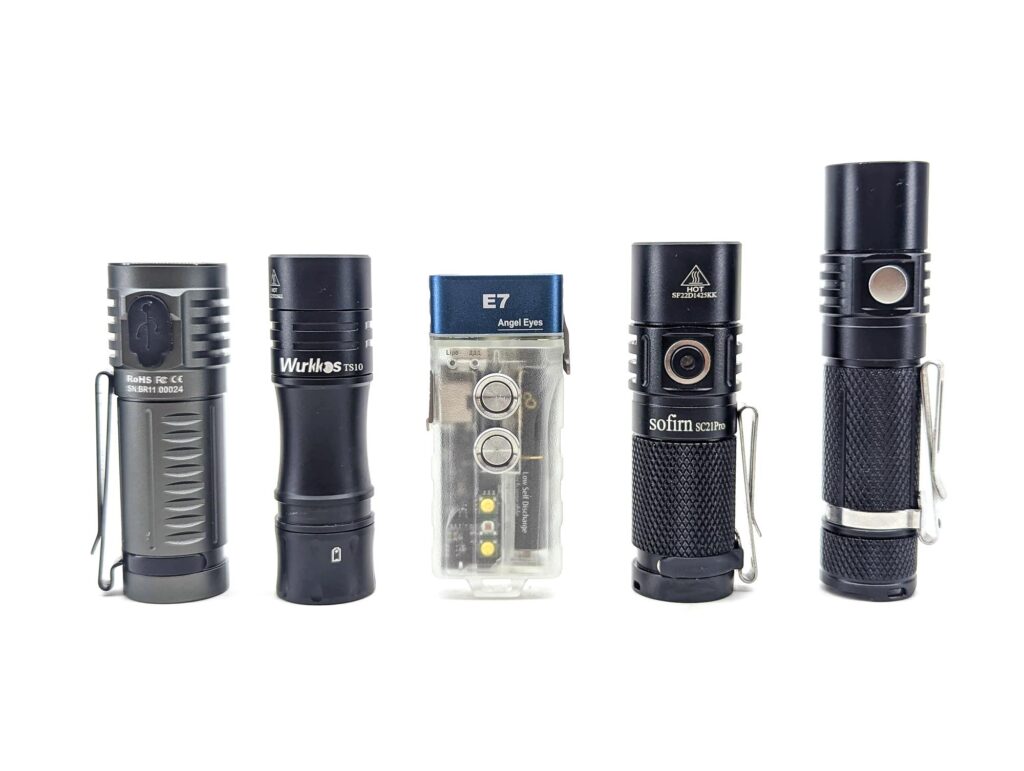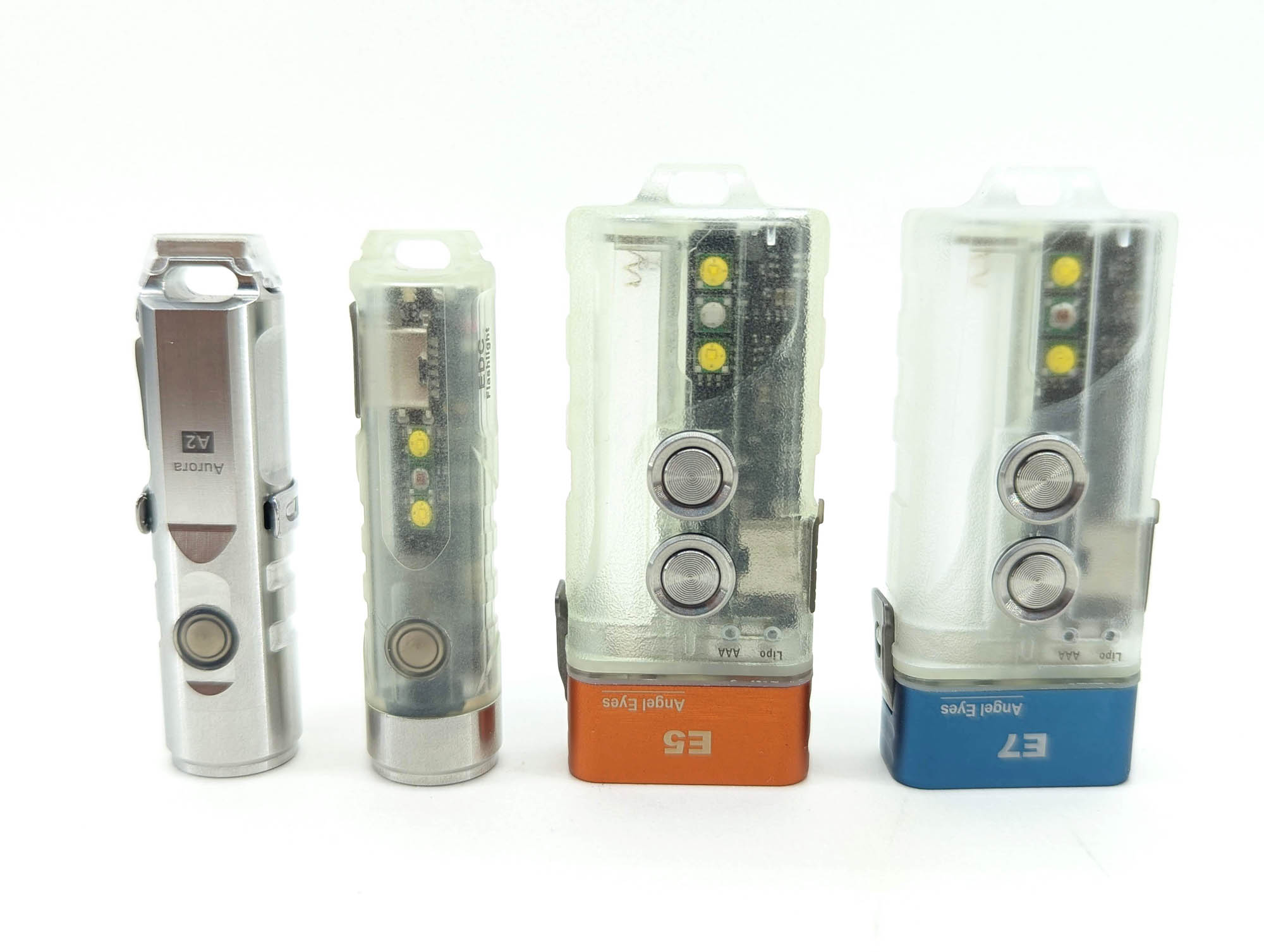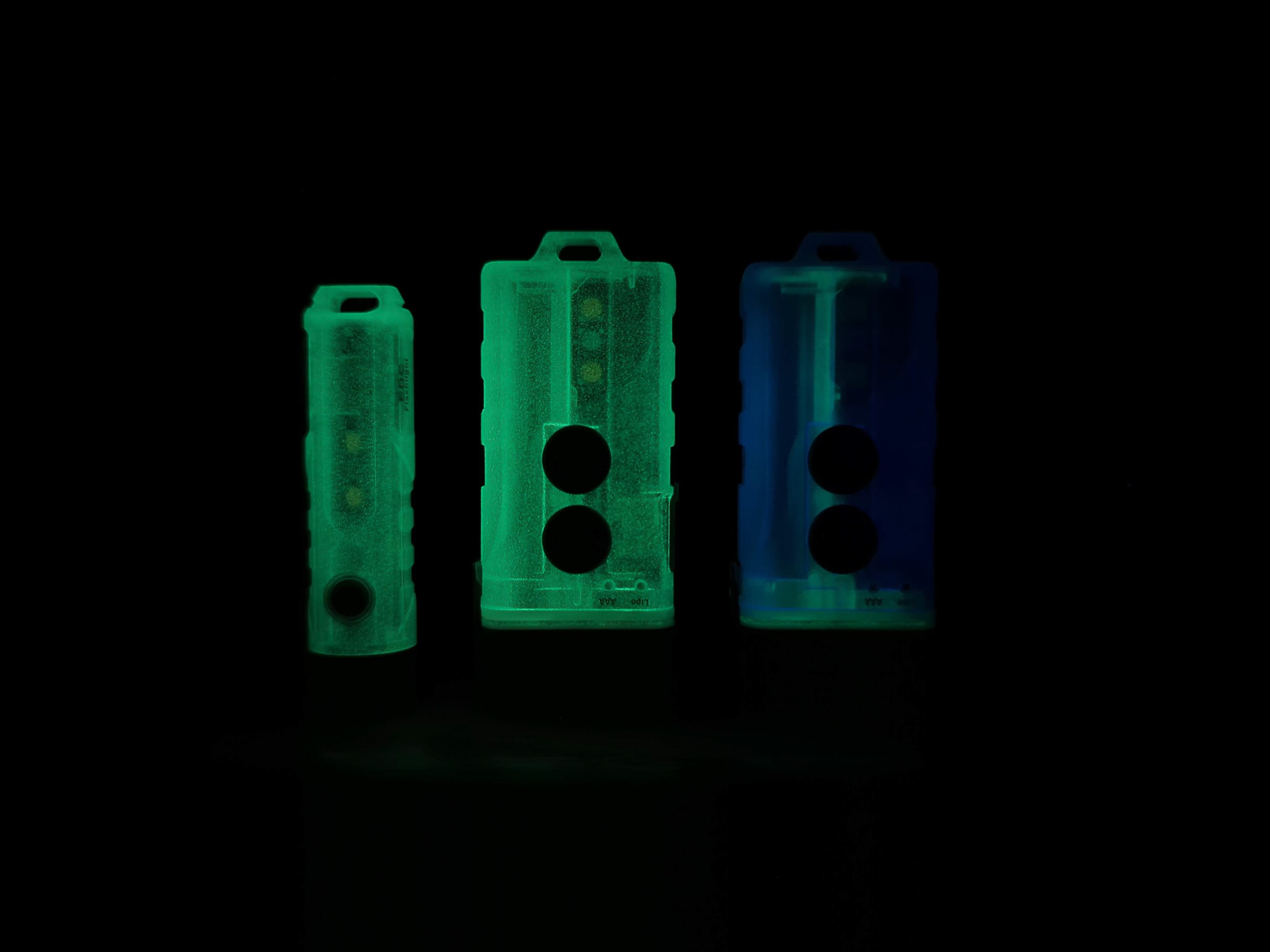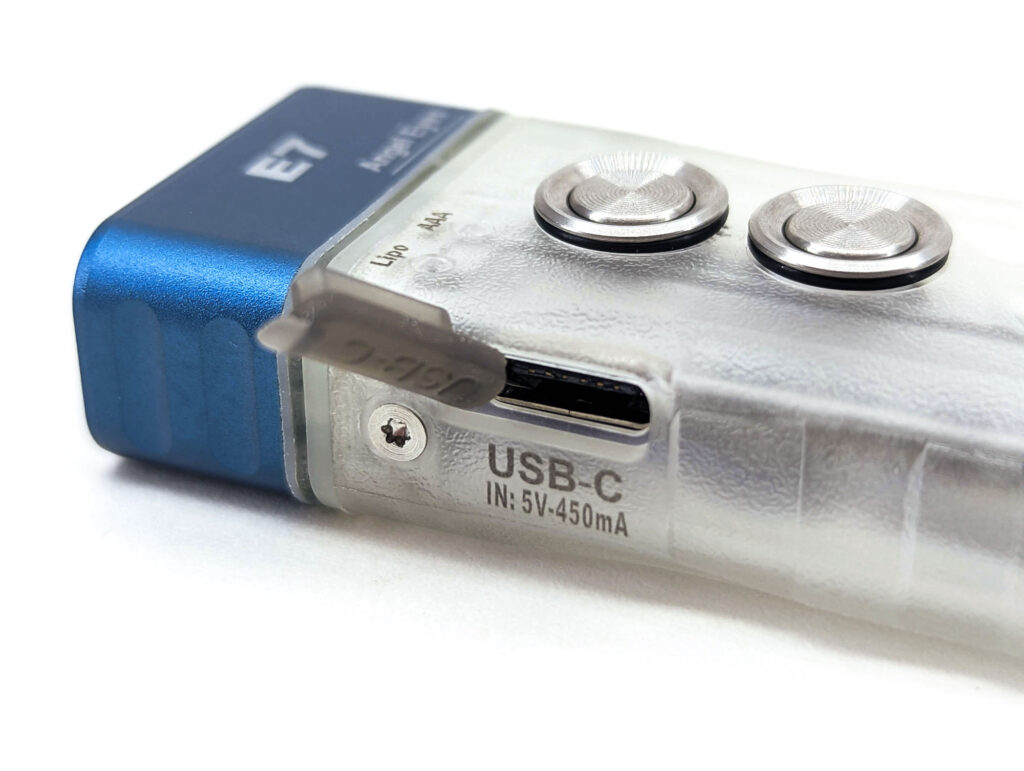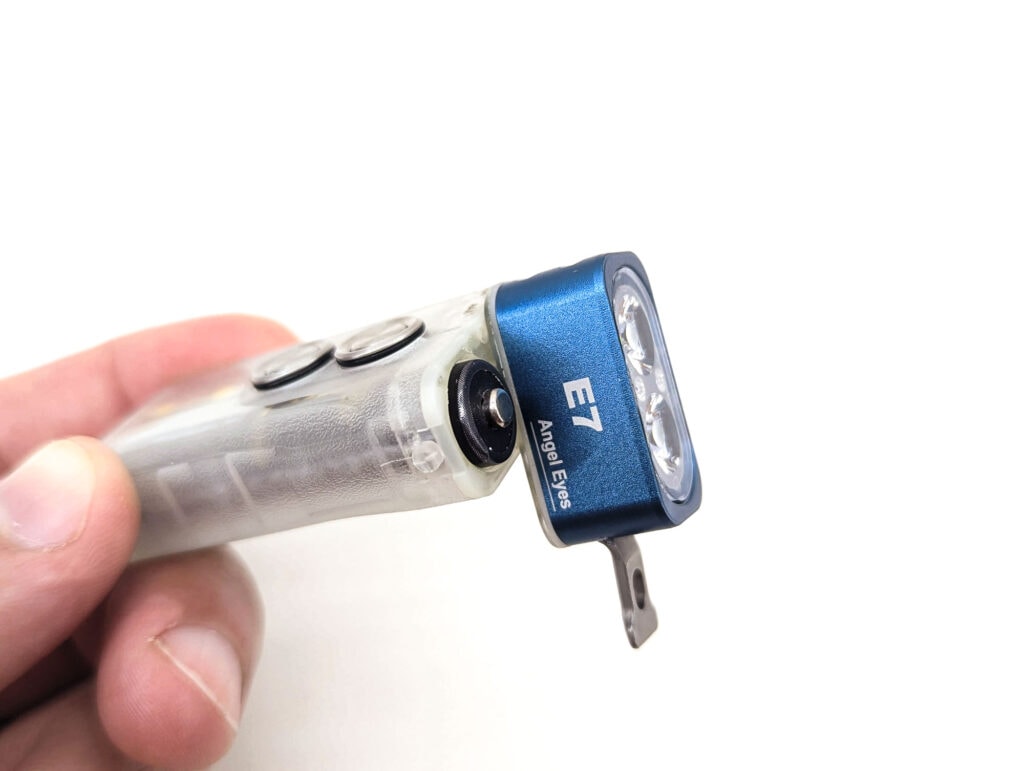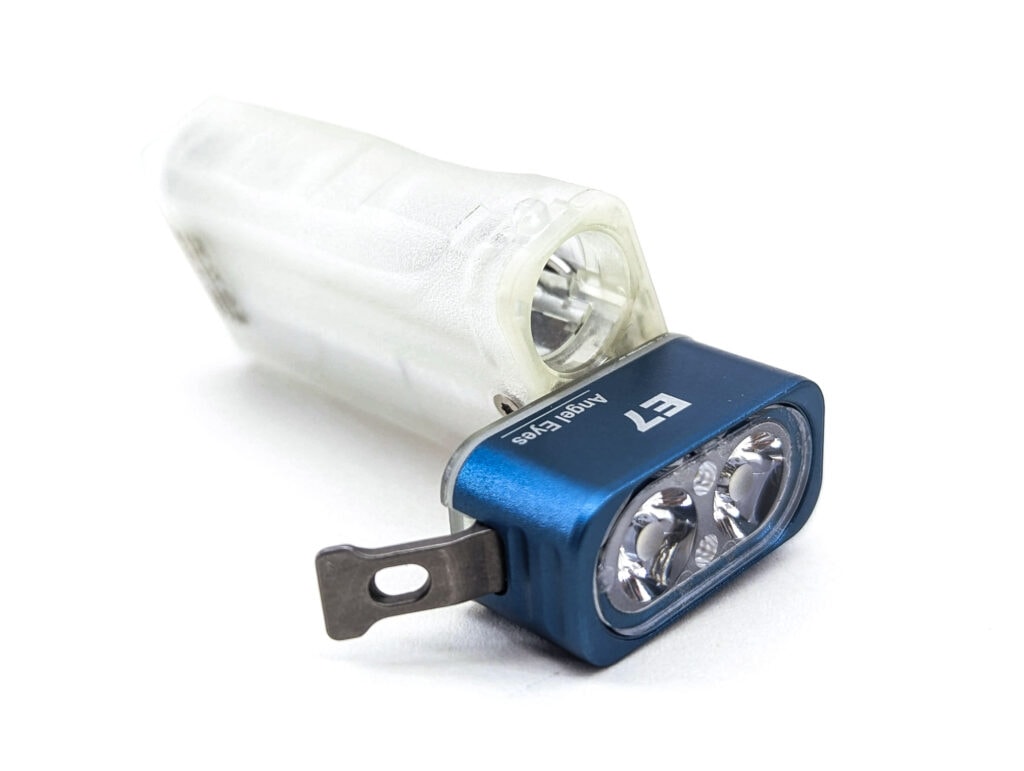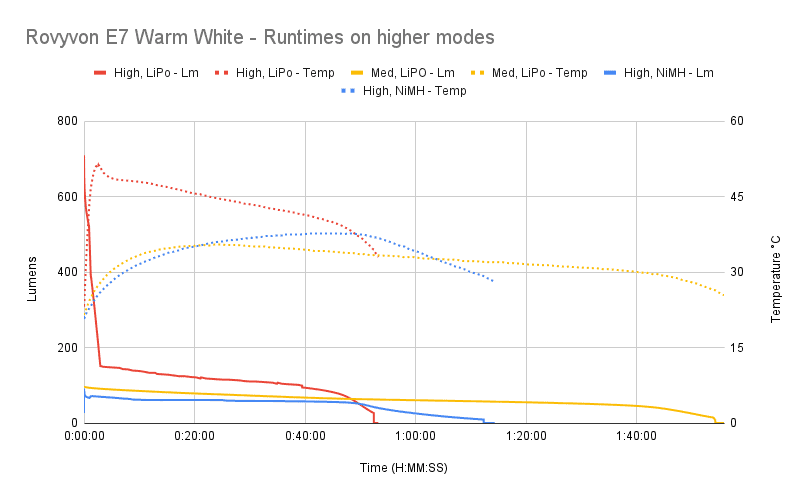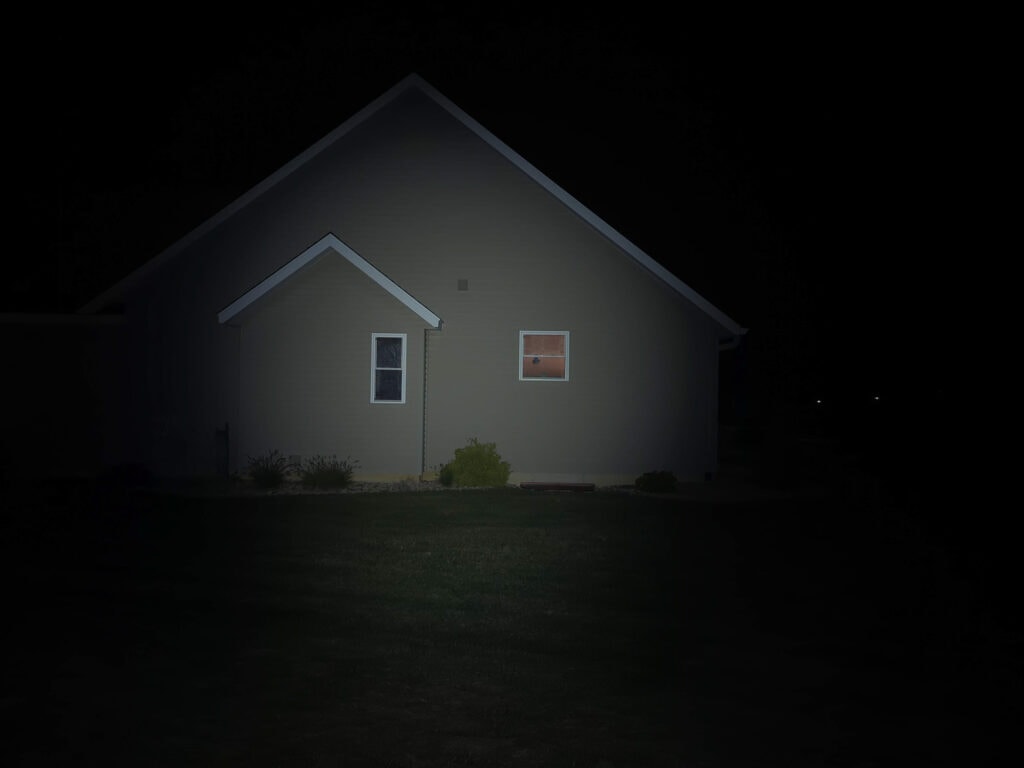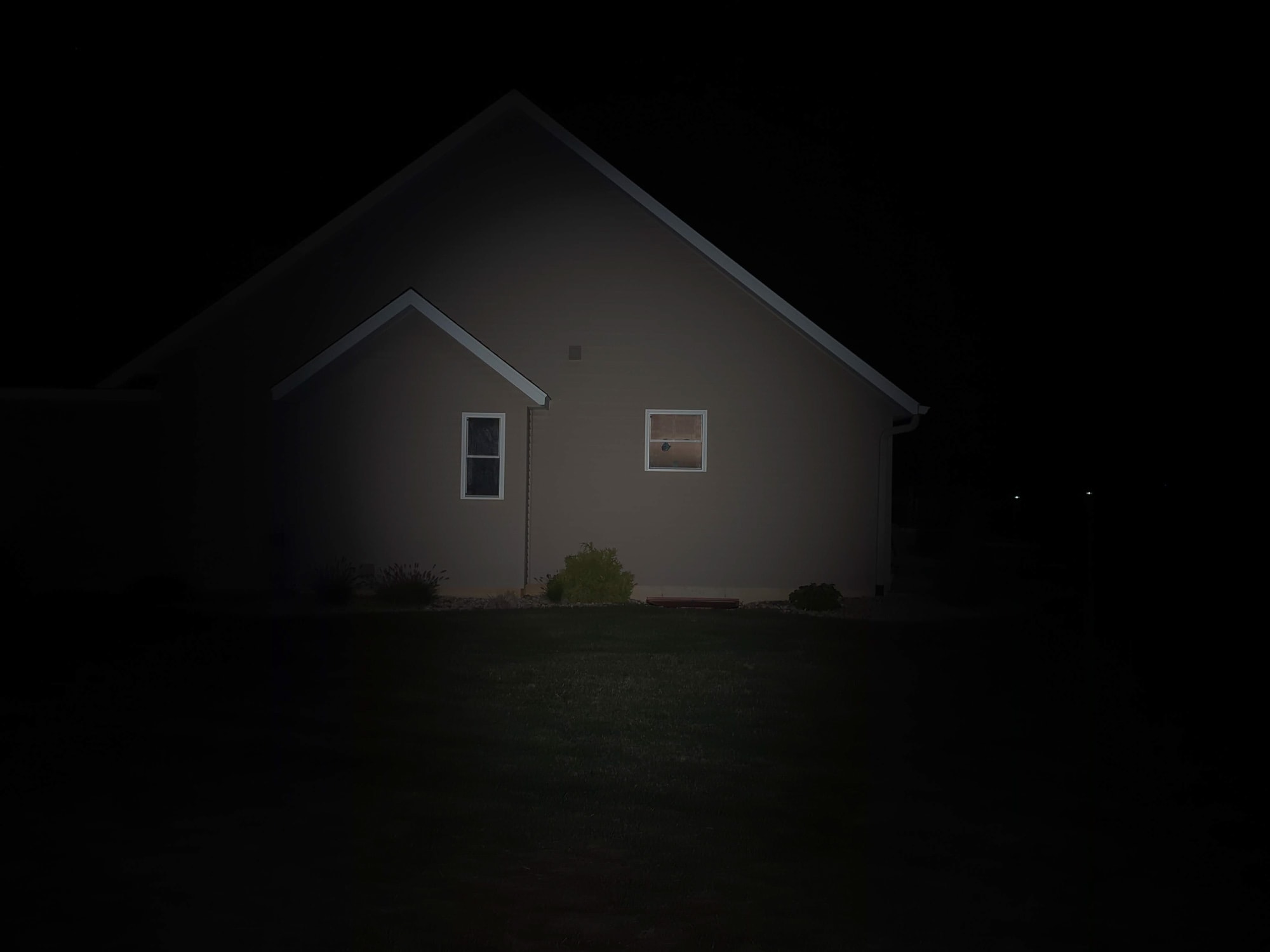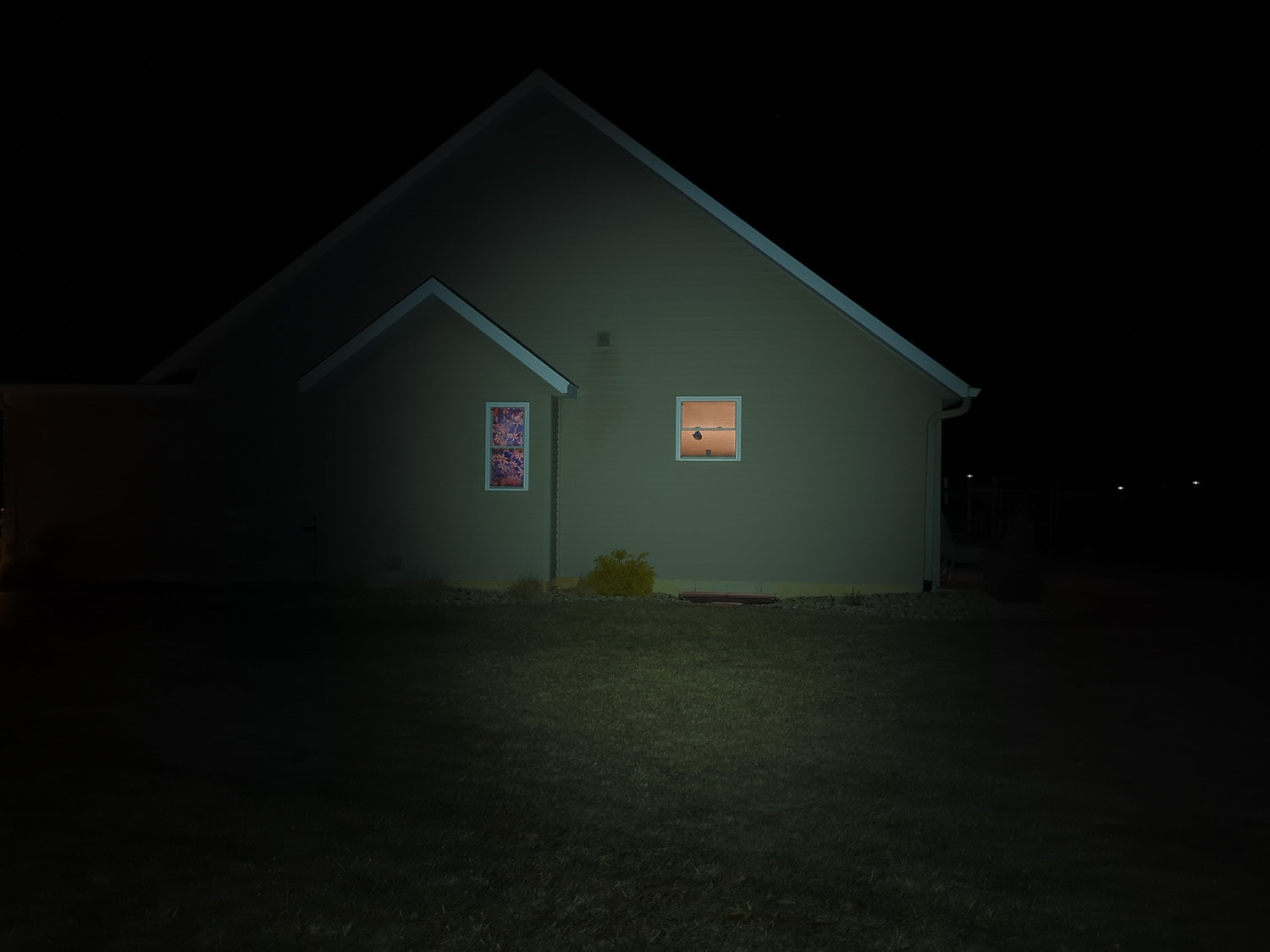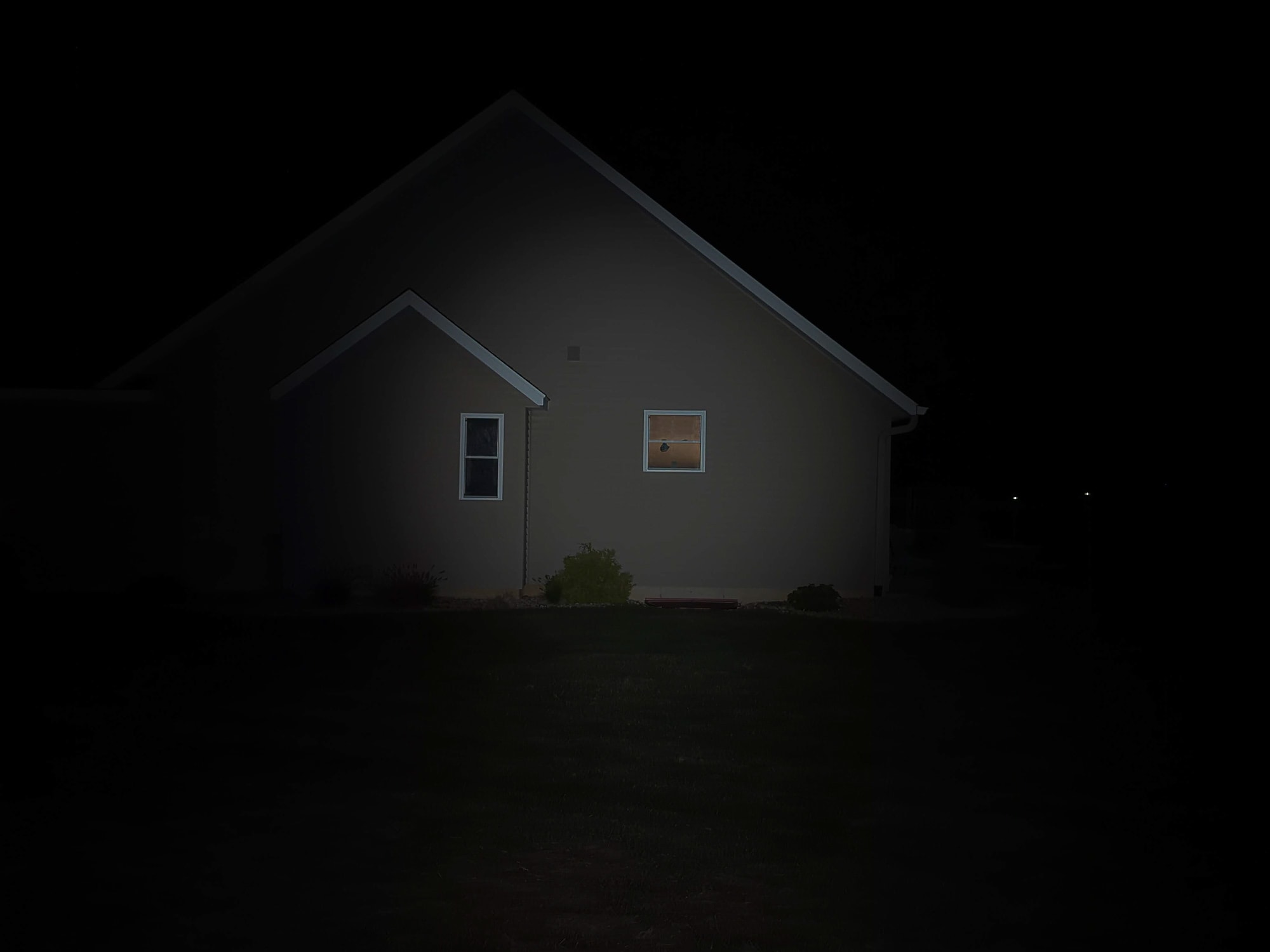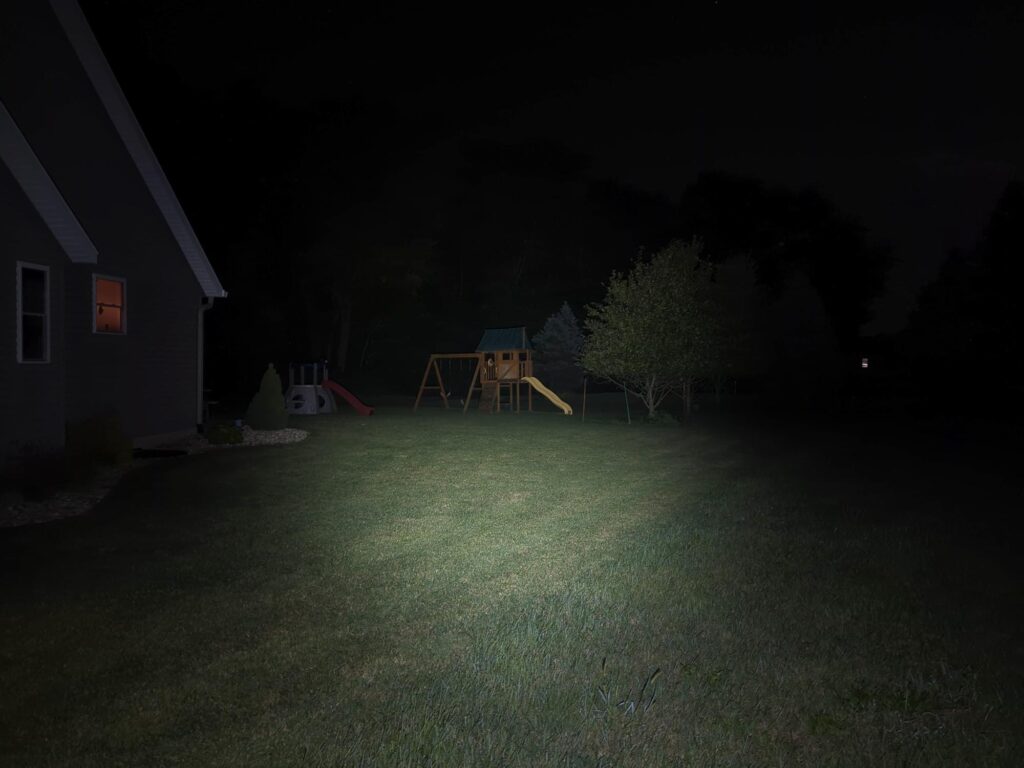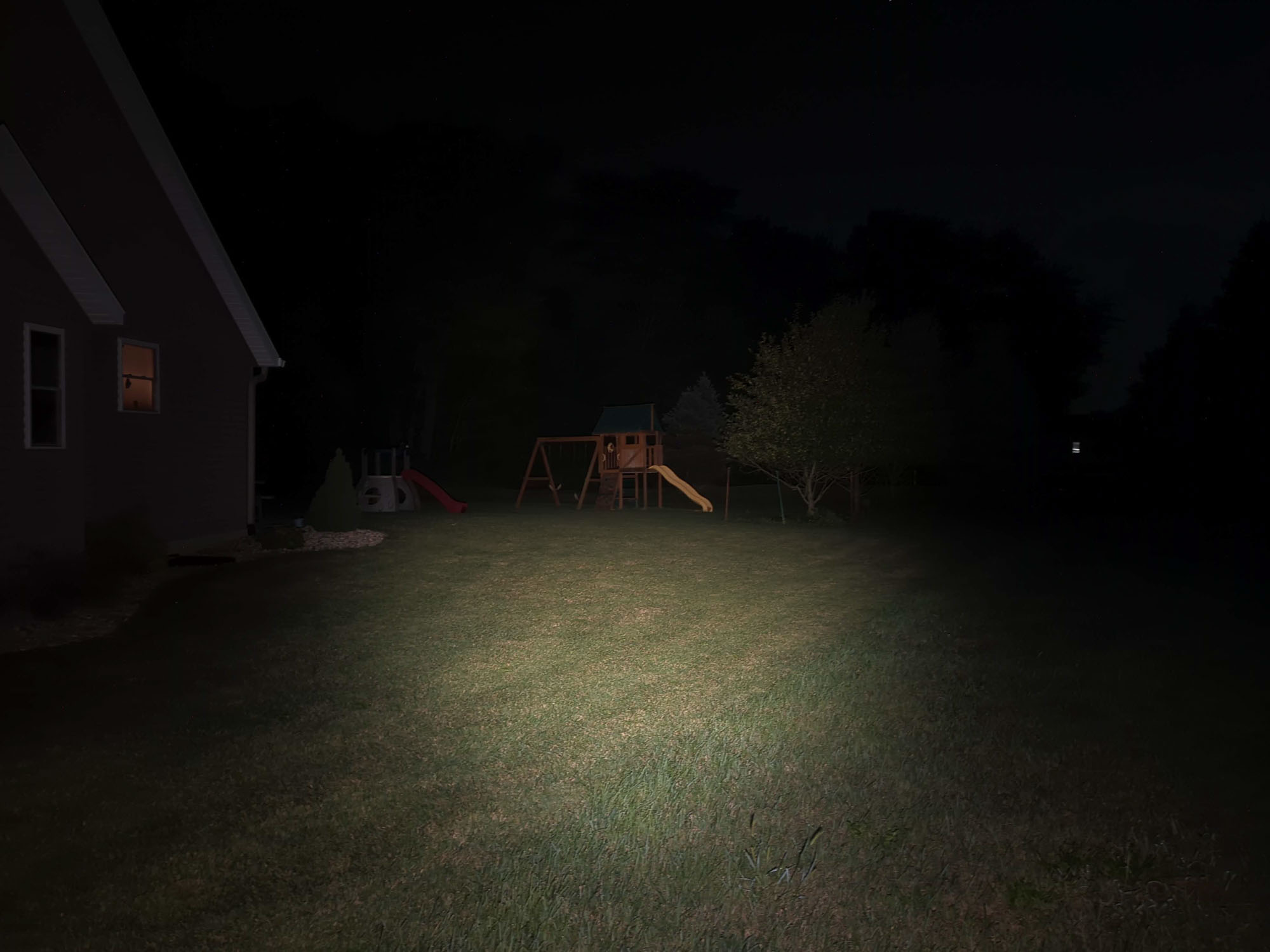1lumen selects and reviews products personally. We may earn affiliate commissions through our links, which help support our testing.
RovyVon E7 Angel Eyes review: EDC flashlight
RovyVon E7 specifications
| Brand & Model | Rovyvon “Angel Eyes” E7 (USB-C) |
|---|---|
| Flashlight category | Keychain |
| LED | Luminus SST-20 |
| Max. output | 700 Lumens |
| Max. beam distance | 70 meters |
| Max. beam intensity | 1300 cd |
| Battery config. | Built-in / AAA |
| Onboard charging | USB-C |
| Modes | 8 |
| Blinkies | Strobe, Red Emergency, Red Beacon |
| Waterproof | IPX6 |
| Review publication date | October 2022 |
Introduction:
Rovyvon makes a wide array of compact EDC flashlights. They have a whole lineup of keychain lights in their Aurora series of every shape, material, and color. The “Angel Eyes” E7 is also considered a keychain light, but with a much different form-factor. Instead of a small cylinder shape, the Angel Eyes models are a flat, rectangular affair with two primary LEDs.
I’ve reviewed the RovyVon E3 Pro before, and while the form factor is pretty much identical, the newer Angel Eyes lights from Rovyvon have a couple of new tricks including a second button. But that’s not the only thing that’s new – keep reading!
Package quality.
The packaging of this RovyVon E7 is the same as what I saw previously with other RovyVon lights – a nice, plastic clamshell case. The E7 was held in place with a piece of cut-out paperboard, under which sat the accessories. In all, the package contained:
- RovyVon E7
- Pocket clip
- Split rings (two different ones)
- Spare USB cover
- Manual
- Warranty card
Flashlight in use
The RovyVon E7 is quite small; it disappears into the hand. Imagine a box of Tic Tacs, but a bit more narrow. The side profile of the E7 puts it barely larger than my smallest AAA lights, the Olight i3E EOS and Skilhunt E3A. But of course it’s about twice as wide. This slim and flat profile lets it practically disappear into your pocket..
That nearly-deep-carry clip can be positioned either direction. One direction puts the LEDs down into my pocket, which is my preferred method of carry for lights. You can easily and quickly flip that around which makes it ready to clip onto the brim of a ballcap. There are 3 sets of grooves in the sides of the E7 that look like they’d be appropriate for mounting the switch. But alas, that’s not the case. Two sets are smaller and the clip doesn’t fully seat in them. You can only use the central-most grooves for the clip. The clip stays on fairly well, but I wouldn’t put my faith in it to keep the E7 attached outside of my clothing. If anything, the clip seems slightly too narrow for the body of the light.
Unlike the E3 Pro that I reviewed previously, the RovyVon E7 has not one, but two switches. The switches have a raised ring around them that does a decent job of preventing accidental activations. They also help you find the button easily. Generally speaking, the top button controls the front/main LEDs while the lower button controls the side lights. Those sidelights? Oh yeah, those. That’s another new thing for the Angel Eyes lights. The E7 has your choice of warm white + UV or warm white + red aux emitters, just like many of the Aurora series lights!
The package includes two different styles of split rings for use on your keychain. I’ll be honest, while I love keychain flashlights, I’d never put one on a keychain. I’m a bit of a minimalist and I’d never have much on my keyring besides my truck key, it’s remote fob, and a house key. I think the E7 is small enough that you certainly could keep it on your keys if you don’t mind a little bit of added bulk. For someone that won’t ever attach this to my keys, the large, protruding keyring attachment point on the end does irk me a little bit. I wish that RovyVon could have found a way to integrate a flush-mount keyring attachment point.
Despite its small size, the E7 Angel Eyes packs quite a punch. But this is a keychain light, so keep your expectations in check. It boasts 700 lumens (for the cool white, or 500 lumens for the warm white version) in a tiny package, so it’s good for either short bursts of bright light (like navigating to your car or door) or longer running low-light tasks (like reading a book).
Build Quality, and Warranty
Just like in the Aurora series, RovyVon offers several body materials for the Angel Eyes E-series: polyamide, fluorescent polycarbonate, aluminum, and titanium. Even within those choices, you have many more choices. The polycarbonate comes in Green and Blue GITD (glow in the dark), raw or patterned titanium, several colors of aluminum anodizing, etc. The E7 model is specifically GITD Blue fluorescent polycarbonate.
The E7 may be rectangular, but attention was made to keep it from being a plain old box. The sides have a series of grooves (one of which is for the clip, the rest are cosmetic). The center of the faces features a wave pattern with the raised surface being matte and the lower surface being smooth. The head of the light is aluminum, which should help a bit with heat dissipation. And the rest of the body is GITD polycarbonate, which is pretty neat and keeps things extremely lightweight. The GITD blue looks cool and can help you find it in the dark, especially if it’s been charged up with sunlight (or the built-in UV light if you went with that model). When compared to the GITD green model (the E5), the GITD blue glows much more dimly than the green.
Warranty Policy (copied from RovyVon’s website):
- Within 2 years of purchase, we will replace or repair it as long as the product is not working anymore because of the factory defects. This does not include obvious user wear or extreme damage.
- After 2 years of purchase, if your product(s) got a defective or issues, we’ll offer a discount for purchasing new product(s) at a same or similar value.
LED, Lens, Bezel, Beam, and Reflector
Throughout their Angel Eyes line-up, RovyVon offers two emitter options: a cool white 6500K 70-CRI Luminus SST-20 and a warm white 4000K 95-CRI Luminus SST-20. Like most LED choices, it’s a trade off between quantity (lumens) and quality (color rendering). This E7 showed up sporting the 6500K 70-CRI SST20 LEDs. The 6500K SST20 is a pretty common LED and does a pretty good job of efficiently making a clean beam, albeit with cool, low-CRI light and is known for being a bit green-tinted.
The two LEDs sit below a smooth and fairly narrow TIR optic. The optic is either glued in place or has some sort of sealant around it.
Opple Light Master reading on High at 1 meter:
- CCT: 5793K
- CRI: 66.0 Ra
- DUV: +0.0095
Dimensions and size comparison
Dimensions:
| Dimension | Millimeters | Inches |
|---|---|---|
| Length | 66.1 | 2.6 |
| Width | 27.5 | 1.08 |
| Height | 13.5 | 0.53 |
Weight:
| Weight | Grams | Oz. |
|---|---|---|
| Without battery: | 30 | 1.06 |
| With battery (Eneloop Pro AAA) | 42 | 1.48 |
Flashlight size comparison with its competition
Group 1 (Angel Eye lights): RovyVon E7, RovyVon E5, RovyVon E3 Pro
Group 2 (EDC lights): ThruNite T1S, Wurkkos TS10, RovyVon E7, Sofirn SC21 Pro, Sofirn SP10 Pro
Group 3 (3rd Gen / USB-C RovyVons): RovyVon A2, RovyVon A5, RovyVon E5, RovyVon E7
Group 4 (GITD Rovyons): RovyVon A5, RovyVon E5, RovyVon E7
Driver & User Interface:
RovyVon’s UI is a bit unique. At first, I was turned off by it. But after carrying a RovyVon in my pocket for the past few months, I’ve gotten quite used to it. The UI is certainly different, but it seems purpose-built for pocket/keychain carry with a focus on preventing accidental activations without making you use the lockout mode.
In the description below, Button 1 is the top/front button which is used for controlling the primary LEDs. Button 2 is the lower/rear button which is used for controlling the aux LEDs.
Available modes: Moonlight, Low, Medium, High, Aux White Low, Aux White High, Aux Red Low, Aux Red High
Available blinky modes: Strobe, Red Emergency, Red Beacon
User interface:
From OFF:
- Button 1, Press and Hold: momentary High
- Button 1, Single click: Moonlight
- Button 1, Double click: turn On (memorized level)
- Button 1, 3 clicks: Strobe
- Button 1, 4 clicks: Lock
- Button 2, Single click: warm white sidelight On
- Button 2, Double click: red sidelight On (memorized level)
- Button 3, 3 clicks: red emergency
From ON:
- Button 1, Press and Hold 0.5 sec: turn Off
- Button 1, Single click: change mode (Low > Med > High)
- Button 1, 3 clicks: Strobe
- Button 1, 3 clicks while in Moonlight: switch between Lipo and AAA battery, if installed
- Button 2, Single click: cycle between aux modes (low/high and emergency/beacon)
Mode memory:
- Yes, the last used “normal” mode (Low, Medium, or High) will be memorized
- It appears to be a true last-mode memory, not the timed memory of the Aurora series
- The white aux/sidelights do not have memory, they always come on in Low
- The red aux/sidelights do have have memory
Shortcuts:
- To Moonlight: single click Button 1 from Off
- To High: (momentary) hold Button1 from Off
- To Strobe: triple click Button 1 from Off or On
- To white aux low: single click Button 2
Low voltage warning:
- N/A
Strobe/blinkies
- Strobe is accessed via a triple click of Button 1
- Red emergency is accessed by a triple click of Button 2
- In red emergency mode, a single click of Button 2 goes to red beacon mode
Lock-out mode:
- Activate lockout with 4 quick clicks of Button 1
- Unlock with another 4 quick clicks of Button 1
PWM
- Yes, I’ve measured 47.0 kHz PWM which is fast enough to not be noticed by most people
Additional info on the UI:
- Depending on what model you go with, there may be some UI differences. RovyVon offers two configurations for the sidelights: Warm White + UV and Warm White + Red.
- If you have a use for the Red LEDs, go for that model, otherwise, the UV LED is handy for getting the GITD body to charge up quickly (which RovyVon states is actually the primary purpose of the UV LED, especially since the entire body glows up and gives off visible light when you turn on the UV LED).
Batteries & Charging
The battery situation with the RovyVon E7 is a bit unique. It has a small (around 330 mAh) LiPo battery that’s built-in. This helps keep the size small and the output fairly high. But what if the LiPo isn’t enough? Just slide in your favorite AAA battery to supplement the LiPo. When you do so, the E7 will default to using the AAA for the power source, but you can manually switch between the AAA and the LiPo (triple click from Moonlight).
As I do with any AA or AAA powered light, I recommend a high-quality NiMH battery such as an Eneloop. You certainly can use an alkaline battery, but you run the risk of battery leakage ruining your nice light. That’s ok in a pinch, but I wouldn’t trust alkaline batteries in the long run. RovyVon also calls out that you can indeed use 10440 cells in the AAA slot. If you have a battery loaded in, when your selected power source runs low, it will automatically switch over to the other battery (be it LiPo or AAA).
The charge rate is stated as 450 mA. When plugged into my USB meter, I saw a 0.46 amp / 2.30 watt charge rate that completed between 49 and 60 minutes depending on the test. The indicator LED next to the charging port lights up “breathing” blue when the E7 is charging and turns green when the charge cycle is complete.
Performance test
Lux was measured by a UNI-T UT383 BT at 5 meters. Lumens were measured in a homemade lumen tube using a TSL2591 sensor, calibrated with a Maukka calibration light. The temperature was monitored with an MLX90614 IR temperature sensor.
Lumen measurements
The specs are for the warm white model that I have here. The cool white specs are higher.
| Mode | Specified | turn on | 30 sec | 10 minutes |
|---|---|---|---|---|
| LiPo, Moonlight | 0.5 lm | 0.4 lm | 0.4 lm | |
| LiPo, Low | 10 lm | 12 lm | 12 lm | 11 lm |
| LiPo, Medium | 100 lm | 96 lm | 95 lm | 85 lm |
| LiPo, High | 700 lm | 710 lm | 557 lm | 138 lm |
| NiMH, Moonlight | 0.5 lm | 0.4 lm | 0.4 lm | |
| NiMH, Low | 5 lm | 9 lm | 9 lm | |
| NiMH, Medium | 20 lm | 20 lm | 20 lm | 21 lm |
| NiMH, High | 100 lm | 92 lm | 69 lm | 62 lm |
Parasitic drain:
- N/A (can’t measure due to internal battery)
Overall, my readings seem to be right in line with what RovyVon has stated. Like other RovyVon lights, in High mode, output starts dropping immediately as soon as you turn the light on.
Battery Life: Runtime graphs
For the NiMH tests, I used a Fujitsu black 900 mAh (aka, Eneloop Pro)
| Mode | Specified | Measured runtime (ANSI) | Time till shut off |
|---|---|---|---|
| LiPo, Moon | 62 hr | – | – |
| LiPo, Low | 14 hr | 13 hr 22 min | 13 hr 22 min |
| LiPo, Medium | 2 hr | 1 hr 54 min | 1 hr 54 min |
| LiPo, High | 3 min + 1 hr | 49 min | 52 min |
| NiMH, Medium | N/A | 5 hr 33 min | 5 hr 33 min |
| NiMH, High | N/A | 1 hr 12 min | 1 hr 12 min |
The observed runtimes are very close to what RovyVon has stated.
ANSI FL1 standards: The runtime is measured until the light drops to 10% of its initial output (30 seconds after turning on). This does not mean that the flashlight is not usable anymore. The last column shows how long the light actually works till it shuts off. If there is a + symbol, it means that the test was stopped at that particular point, but the light was actually still running. This happens on certain occasions, with certain drivers, firmware, or batteries.
Peak beam intensity and beam distance measurements
Measured at 5 meters. Specs are for the warm white model; cool white specs are higher
| Mode | Specified | Candela measured | Meters | Yards |
|---|---|---|---|---|
| Medium | 300 cd | 500 cd | 45 | 49 |
| High | 1300 cd | 2800 cd | 106 | 116 |
Extra info: Peak beam distance according to ANSI FL1 standards: The calculated value of distance in meters at which the flashlight produces a light intensity of 0.25 lux. (0.25 lux is about the brightness of a full moon shining on an object).
Beamshots: RovyVon E7 vs E5 vs E3 vs A5
Beam shots of the building are taken at 15 m (16 yd) using a Pixel 6 set to ISO 200 with 1/10 second exposure time.
Beam shots of the playset are taken at 30 m (33 yd) using a Pixel 6 set to ISO 200 with 1/2 second exposure time. The trees in the background are around 65 m away.
Beamshots compared to the following flashlights:
- RovyVon E7
- RovyVon E5
- RovyVon E3 Pro
- RovyVon A5 (G3)
Disclaimer: This flashlight was sent to me for review at no cost by RovyVon. I have not been paid to review, nor have I been holding back on problems or defects.
Final Verdict
Pros
- Compact little EDC light
- Emitter choices including high CRI
- GITD body is neat
- USB-C charging
- AAA power source option
- Proper Moonlight mode
Cons
- Output ramps down immediately
- CW SST20 has a greenish tint
Explanation on star ratings:
1: Avoid: a match would be a better choice – 2: Poor: significant defect or issues; almost unusable – 3: Average: some defects or issues; but still usable 4: Good: recommended (minor issues) – 5: Great: highly recommended
5 stars: ★★★★★
I’m a big fan of keychain lights, I just choose not to use them on my keychain. When I first saw the RovyVon “Angel Eyes” E7, I knew it was larger than I’d feel comfortable with putting on a keyring, but it would be perfect for my pocket. That slender, flat design works well for slipping into my jeans without any fuss.
RovyVon did a nice job with the styling and function of the light. They provide enough color and LED options to make it your own just-right light. The user interface is a bit unique, but if you’ve used a RovyVon for any amount of time, you’ll pick up on it right away. While the UI is similar to what you find on the Aurora series (double click for On, memorized mode), I find the E-series lights to be even better to use as they include a single-click for Moonlight shortcut. Oh, and the mode memory is last-used instead of the 3-minute timer thing on Auroras. The ability to throw in a AAA in a pinch is a great option for when the built-in LiPo runs out and you don’t have a chance to charge it up. The recent addition of GITD body materials and aux emitters is the icing on the cake for the Angel Eyes models.
The RovyVon E7 appears to be built well, looks good, functions nicely, and disappears into a jeans pocket – ready to go whenever you are. I like it!
Buy your RovyVon E7 here
1lumen selects and reviews products personally. We may earn affiliate commissions through our links, which help support our testing.
